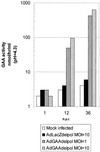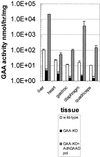Systemic correction of the muscle disorder glycogen storage disease type II after hepatic targeting of a modified adenovirus vector encoding human acid-alpha-glucosidase
- PMID: 10430861
- PMCID: PMC17698
- DOI: 10.1073/pnas.96.16.8861
Systemic correction of the muscle disorder glycogen storage disease type II after hepatic targeting of a modified adenovirus vector encoding human acid-alpha-glucosidase
Abstract
This report demonstrates that a single intravenous administration of a gene therapy vector can potentially result in the correction of all affected muscles in a mouse model of a human genetic muscle disease. These results were achieved by capitalizing both on the positive attributes of modified adenovirus-based vectoring systems and receptor-mediated lysosomal targeting of enzymes. The muscle disease treated, glycogen storage disease type II, is a lysosomal storage disorder that manifests as a progressive myopathy, secondary to massive glycogen accumulations in the skeletal and/or cardiac muscles of affected individuals. We demonstrated that a single intravenous administration of a modified Ad vector encoding human acid alpha-glucosidase (GAA) resulted in efficient hepatic transduction and secretion of high levels of the precursor GAA proenzyme into the plasma of treated animals. Subsequently, systemic distribution and uptake of the proenzyme into the skeletal and cardiac muscles of the GAA-knockout mouse was confirmed. As a result, systemic decreases (and correction) of the glycogen accumulations in a variety of muscle tissues was demonstrated. This model can potentially be expanded to include the treatment of other lysosomal enzyme disorders. Lessons learned from systemic genetic therapy of muscle disorders also should have implications for other muscle diseases, such as the muscular dystrophies.
Figures







References
-
- Hirschhorn R. In: The Metabolic and Molecular Bases of Inherited Disease. Scriver C R, Beaudet A L, Sly W S, Valle D, editors. New York: McGraw–Hill; 1995. pp. 2443–2464.
-
- Bijvoet A G A, Kroos M A, Pieper F R, Vandervliet M, Deboer H A, Vanderploeg A T, Verbeet M P, Reuser A J J. Hum Mol Genet. 1998;7:1815–1824. - PubMed
-
- Barton N W, Brady R O, Dambrosia J M, DiBisceglie A M, Doppelt S H, Hill S C, Mankin H J, Murray G J, Parker R I, Argoff C E. N Engl J Med. 1991;324:1464–1470. - PubMed
-
- Nunoya T, Tajima M, Mizutani M. Lab Anim. 1983;17:138–142. - PubMed
Publication types
MeSH terms
Substances
LinkOut - more resources
Full Text Sources
Other Literature Sources
Medical
Research Materials
Miscellaneous

